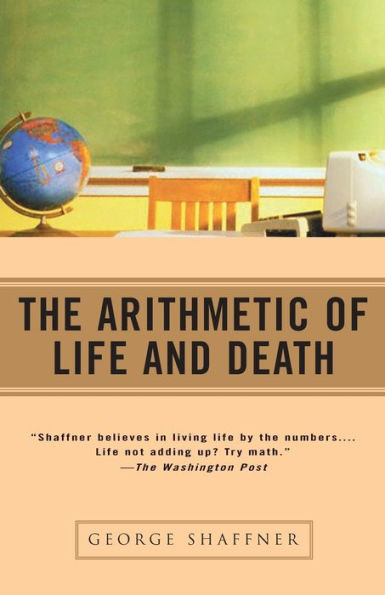

Paperback(FIRST)
-
PICK UP IN STORECheck Availability at Nearby Stores
Available within 2 business hours
Related collections and offers
Overview
Illuminated with anecdotes, humor, and insight, each chapter explains a unique part of life that can be understood only through the magic of numbers. Whether it's an unconventional theory on why more things go wrong than right, a simple calculation of how much it will cost you to smoke for a lifetime, why crime (accumulatively) doesn't pay, or a glimpse into the probability of life after death, this enlightening and lucidly reasoned book will forever change the way you think about numbers—and the world around you.

Product Details
| ISBN-13: | 9780345426451 |
|---|---|
| Publisher: | Random House Publishing Group |
| Publication date: | 05/01/2001 |
| Edition description: | FIRST |
| Pages: | 220 |
| Sales rank: | 544,595 |
| Product dimensions: | 5.56(w) x 8.56(h) x 0.44(d) |
About the Author
Read an Excerpt
CHAPTER
1
The Probability That
You Would Be You
"What is the odds so long as the fire of soul is kindled . . ."
—CHARLES DICKENS
Since some six billion people now occupy planet Earth, one could conclude that human life is as common as dirt in Denmark. There is, however, some evidence to the contrary. Gwendolyn Sharpe, anthropology student, and daughter of a prominent Northwestern personality, is a good example.
Like every human being, Gwendolyn is a construction of forty-six chromosomes. Twenty-three came from her mother, Cecilia, and the other twenty-three came from her estranged father. Each of her parents had forty-six chromosomes from which to choose, nicely organized in twenty-three pairs. Through the miracle of natural selection, either one of each chromosome pair from each of her parents could have been chosen for production. The resulting twenty-three chromosomes from each parent were then paired to make Gwendolyn's forty-six.
The odds that Gwen would get the exact twenty-three chromosomes that she received from her mother were one-half times one-half times one-half times one-half, a total of twenty-three times, or .5 to the twenty-third power.
That means that the probability that Cecilia would give Gwendolyn the twenty-three chromosomes she got was about one in ten million
(10,000,000), which was less likely than winning the state lottery (about one in seven million in Washington, although the odds are longer in some states).
The odds that Gwen would get the twenty-three chromosomes she got from her father were also about one in ten million. So, the probability that Gwendolyn would be Gwendolyn was about one in 100 trillion (one in 100,000,000,000,000). On any given day,
a win in the Washington state lottery would be around fourteen million times more likely than a Gwendolyn Sharpe.
But that assumes the existence, union, and productive sex lives of Gwen's mother and father. Gwendolyn's parents met at a small Pacific Northwest university with a student population of 1,000 men and 1,000 women. Like so many young women back then, Gwen's mother hoped to meet and marry the man of her dreams before leaving college with a degree in accounting. Like so many young men back then, Gwendolyn's father planned to practice a few of the more physical rituals of marriage throughout the six years it would take him to obtain an undergraduate de-
gree in political science. Correctly assuming, however, that Gwendolyn's mother would inevitably prevail, the maximum probability of the productive union of her parents was a one-in-a-thousand long shot, which lengthened the odds of Gwendolyn's existence to about one in 100 quadrillion (1 in
100,000,000,000,000,000).
However, the odds of Gwendolyn's mother's being her mother were at least one in 100 quadrillion, too. The probability that her father would be her father was the same. So the odds of Gwendolyn's being Gwendolyn were closer to one in 1,000,000,000,000,000,000,000,000,
000,000,000,000,000,000,000,000,000. But that figure excludes consideration that either parent might have been infertile, that either might have been killed before conception, or that they might have divorced before the moment of magic that produced Gwendolyn or any of her brothers.
Nor has there been any inclusion of the extreme unlikelihood of the existence of Cecilia's parents, who were from Yakima and Chewelah, or her husband's parents, or their parents, or their parents, ad infinitum.
Netting all of this down to scientific terms, the odds that Gwendolyn would be Gwendolyn were less than one in a jillion gazillion. The same is true for each of us. Against such long odds, every life is a miracle of immeasurable proportion, courtesy of nature. Thus, the existence of so many billions of people is not evidence of the commonness of life but a testament to the infinite scale of nature's benevolence.
Acceptance of such an improbable gift is not without obligation. An annual donation to the National Wildlife Fund is sweet, but the gift of life requires payment in kind. In order to fairly compensate nature for her generosity, each of us must help others to enjoy the gift, we must never harm or take the gift from another, and we must each live our own life to its fullest extent, despite the inevitable bumps in the road.
